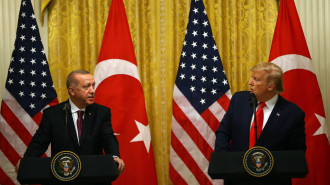Oman looks to a sunnier future
Oman looks to a sunnier future
Analysis: Heavily dependent on oil and gas, Oman is following the lead of other neighbouring countries and harnessing the power of the sun to cut the use of fossil fuels.
3 min read
Oman is using solar power to move away from gas and oil consumption [Getty]
One of the world's biggest solar power farms is to be built in Oman, the sunny southern Gulf country, by a Californian start-up company.
GlassPoint will develop the 1,021 megawatt solar thermal facility for the sultanate's biggest oil and gas producer Petroleum Development Oman (PDO). It will boast the largest energy output of any solar plant in the world, according to its planners.
Looking forward
Miraah, meaning "mirror", should be operational by 2017. It will use 36 greenhouses decked with mirrors to harness the sun's rays at the Amal oil field in south of Oman, converting solar power into steam to extract hard-to-reach heavy oil at the site.
Raoul Restucci, managing director of PDO, said that Miraah is part of PDO's "long-term strategic solution" to extract viscous oil reserves and reduce gas consumption at Amal field "needed elsewhere to diversify Oman's economy and create economic growth".
Oman has been using enhanced oil recovery techniques to recover its hard-to-reach and depleting oil stocks.
Much of Oman's natural gas is consumed locally by the country's fast growing population - including oil producers who use the gas to extract oil.
By using steam instead of gas for extracting oil, the project will help free up more of the sultanate's gas reserves for export and boost the country's coffers.
Now Oman's most recent solar power project should save the country 5.6 trillion British Thermal Units (BTUs) of natural gas each year - enough energy to provide electricity to more than 200,000 of Oman's 4.2 million population.
The site will also be sealed off to prevent frequent sand storms from grinding energy production to a halt.
Countries across the Middle East have been looking at similar projects to produce energy for their rapidly growing populations.
Jordan imports almost all of its resources used for generating energy.
However, with an average of 330 days of sunshine a year, the kingdom is looking to the sun and the wind to tackle a widening gap between energy supply and consumption.
Regional trend
Jordan has suffered from blackouts over the past year, after gas pipelines from Egypt were turned off following frequent attacks by militants based in the Sinai.
The country announced the launch of the "Middle East's largest solar energy project" in the sunshine-rich southern desert region.
Shams Maan solar project will cover 2,000,000 square metres and provide one percent of the country's energy needs. Jordan is hoping that 10 percent of its energy demand will be met by renewables by 2020, according to al-Bawaba.
Even oil giant Saudi Arabia looks set to make the leap into renewable energy, after the country's energy minister said that the kingdom is looking to become a "global power" in solar and wind power, and might even stop using oil and gas by 2040.
As ambitious as this sounds, more countries in the oil-rich Gulf region are looking at economical ways to produce energy, particularly as they look diversify their economies away from a reliance on fossil fuels.
Saudi Arabia, UAE, and Jordan have started work on their own nuclear power plants, while Iran has an active site currently under review with world powers.
Petroleum and gas is heavily subsidised by GCC governments, and Oman, which has rapidly depleting oil reserves, is looking at ways to cut these bills without angering its population.
Low oil prices have also hit the country with a budget deficit predicted to be $3.6 billion for 2015, or 13 percent of the country's GDP.
While oil and gas still account for around 85 percent of Oman's revenues, oil reserves are thought to be running low.
Muscat is desperately trying to find new avenues to diversify its country, but luckily it can boast a relatively safe and stable country with stunning nature and coastlines.
Tourism is viewed as key area for growth and Oman is investing heavily in promoting the country abroad.
With such pride in the country's "beauty" it is little suprise that many are beginning to realise the importance of "clean" wind and solar energy use in the future, while many of Oman's neighbours pursue the nuclear option.
GlassPoint will develop the 1,021 megawatt solar thermal facility for the sultanate's biggest oil and gas producer Petroleum Development Oman (PDO). It will boast the largest energy output of any solar plant in the world, according to its planners.
Looking forward
Miraah, meaning "mirror", should be operational by 2017. It will use 36 greenhouses decked with mirrors to harness the sun's rays at the Amal oil field in south of Oman, converting solar power into steam to extract hard-to-reach heavy oil at the site.
Raoul Restucci, managing director of PDO, said that Miraah is part of PDO's "long-term strategic solution" to extract viscous oil reserves and reduce gas consumption at Amal field "needed elsewhere to diversify Oman's economy and create economic growth".
Oman has been using enhanced oil recovery techniques to recover its hard-to-reach and depleting oil stocks.
Much of Oman's natural gas is consumed locally by the country's fast growing population - including oil producers who use the gas to extract oil.
By using steam instead of gas for extracting oil, the project will help free up more of the sultanate's gas reserves for export and boost the country's coffers.
| Oman has been using similar enhanced oil recovery techniques to recover its hard-to-reach oil stocks. |
Now Oman's most recent solar power project should save the country 5.6 trillion British Thermal Units (BTUs) of natural gas each year - enough energy to provide electricity to more than 200,000 of Oman's 4.2 million population.
The site will also be sealed off to prevent frequent sand storms from grinding energy production to a halt.
Countries across the Middle East have been looking at similar projects to produce energy for their rapidly growing populations.
Jordan imports almost all of its resources used for generating energy.
However, with an average of 330 days of sunshine a year, the kingdom is looking to the sun and the wind to tackle a widening gap between energy supply and consumption.
Regional trend
Jordan has suffered from blackouts over the past year, after gas pipelines from Egypt were turned off following frequent attacks by militants based in the Sinai.
The country announced the launch of the "Middle East's largest solar energy project" in the sunshine-rich southern desert region.
Shams Maan solar project will cover 2,000,000 square metres and provide one percent of the country's energy needs. Jordan is hoping that 10 percent of its energy demand will be met by renewables by 2020, according to al-Bawaba.
Even oil giant Saudi Arabia looks set to make the leap into renewable energy, after the country's energy minister said that the kingdom is looking to become a "global power" in solar and wind power, and might even stop using oil and gas by 2040.
As ambitious as this sounds, more countries in the oil-rich Gulf region are looking at economical ways to produce energy, particularly as they look diversify their economies away from a reliance on fossil fuels.
Saudi Arabia, UAE, and Jordan have started work on their own nuclear power plants, while Iran has an active site currently under review with world powers.
Petroleum and gas is heavily subsidised by GCC governments, and Oman, which has rapidly depleting oil reserves, is looking at ways to cut these bills without angering its population.
Low oil prices have also hit the country with a budget deficit predicted to be $3.6 billion for 2015, or 13 percent of the country's GDP.
While oil and gas still account for around 85 percent of Oman's revenues, oil reserves are thought to be running low.
Muscat is desperately trying to find new avenues to diversify its country, but luckily it can boast a relatively safe and stable country with stunning nature and coastlines.
Tourism is viewed as key area for growth and Oman is investing heavily in promoting the country abroad.
With such pride in the country's "beauty" it is little suprise that many are beginning to realise the importance of "clean" wind and solar energy use in the future, while many of Oman's neighbours pursue the nuclear option.







 Follow the Middle East's top stories in English at The New Arab on Google News
Follow the Middle East's top stories in English at The New Arab on Google News


